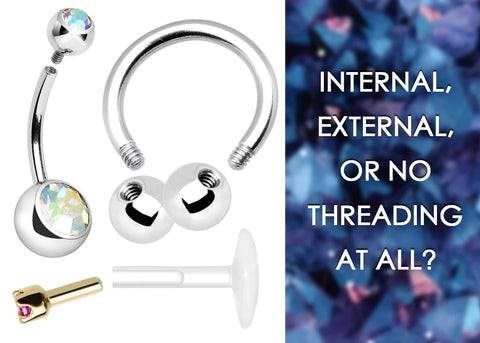Threading: The Ins And Outs
Whether you’re preparing to get your first piercing or you’re a body mod veteran, you may have noticed that the term “threading” comes up quite a lot. What does it mean? And more importantly, what does it mean to YOU? Today we’re going to explain the different kinds of threading and how they can affect your piercings.

First of all, threading is how the end portion of your jewelry attaches to the bar portion. If the ball end screws onto the barbell, this is threaded jewelry. Externally threaded jewelry means that the ball end screws onto the barbell, with the receiving portion inside the ball end. The barbell would have a small piece sticking out of the end, which is what couples with the inside of the ball end. Externally threaded jewelry is entirely inappropriate for getting pierced with. Since the threaded part is on the jewelry itself, it must pass through length of the fistula in order for the jewelry to be removed. In a fresh piercing, your body has all these fragile new cells lining the fistula, completing the healing process. The rough texture of the threads can damage these cells, delaying the completion of the healing and potentially setting the new piercing up for problems. This may be alright for a fully healed piercing but it’s not ideal for a new piercing. If your piercer wants to use externally threaded jewelry, definitely consider getting a second opinion.


Internally threaded jewelry is the reverse of externally threaded in that the receiving portion is inside the barbell and the threads are located on the ball end. They stick out like a textured little nub. This allows the barbell to move smoothly and safely through your piercing, fresh or fully healed. Because drilling into the barbell requires more precision, internally threaded jewelry tends to be made of higher quality materials, and a bit more expensive, although this is not a hard-and-fast rule. Depending on the quality of the metal (ASTM F-136 titanium is always a safe bet), internally threaded jewelry is acceptable for getting a fresh piercing, as well as wearing in an established piercing.

Finally, there is threadless jewelry – a newer style that lets you put the whole internal/external decision in your rearview mirror. This style has a small length of wire-like metal on the ball end and the barbell has a hollow portion that receives it. By bending the wire ever so slightly, it creates a bend that keeps the ball end firmly attached the barbell. This style is excellent for a fresh piercing. It’s also great for cartilage piercings with visible ends because you can change the end without changing the entire piece of jewelry. Threadless ends are available in a myriad of styles and colors and are perfect for people who like to change up their look frequently.
Threading types can be a bit confusing, even to people who have been getting pierced for years. Hopefully armed with this information, you can make the proper choice about what is best for you and for your body! Happy piercing!
